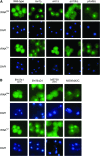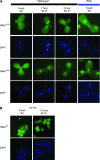Inorganic phosphate deprivation causes tRNA nuclear accumulation via retrograde transport in Saccharomyces cerevisiae
- PMID: 17409072
- PMCID: PMC1894612
- DOI: 10.1534/genetics.106.069732
Inorganic phosphate deprivation causes tRNA nuclear accumulation via retrograde transport in Saccharomyces cerevisiae
Abstract
Nuclear export of tRNA is an essential eukaryotic function, yet the one known yeast tRNA nuclear exporter, Los1, is nonessential. Moreover recent studies have shown that tRNAs can move retrograde from the cytosol to the nucleus by an undefined process. Therefore, additional gene products involved in tRNA nucleus-cytosol dynamics have yet to be identified. Synthetic genetic array (SGA) analysis was employed to identify proteins involved in Los1-independent tRNA transport and in regulating tRNA nucleus-cytosol distribution. These studies uncovered synthetic interactions between los1Delta and pho88Delta involved in inorganic phopsphate uptake. Further analysis revealed that inorganic phosphate deprivation causes transient, temperature-dependent nuclear accumulation of mature cytoplasmic tRNA within nuclei via a Mtr10- and retrograde-dependent pathway, providing a novel connection between tRNA subcellular dynamics and phosphate availability.
Figures





Similar articles
-
A Los1p-independent pathway for nuclear export of intronless tRNAs in Saccharomycescerevisiae.Proc Natl Acad Sci U S A. 2002 Apr 16;99(8):5412-7. doi: 10.1073/pnas.082682699. Proc Natl Acad Sci U S A. 2002. PMID: 11959996 Free PMC article.
-
Genome-wide screen uncovers novel pathways for tRNA processing and nuclear-cytoplasmic dynamics.Genes Dev. 2015 Dec 15;29(24):2633-44. doi: 10.1101/gad.269803.115. Genes Dev. 2015. PMID: 26680305 Free PMC article.
-
tRNA turnaround.Mol Cell. 2005 Aug 5;19(3):292-4. doi: 10.1016/j.molcel.2005.07.009. Mol Cell. 2005. PMID: 16061175
-
Review: transport of tRNA out of the nucleus-direct channeling to the ribosome?J Struct Biol. 2000 Apr;129(2-3):288-94. doi: 10.1006/jsbi.2000.4226. J Struct Biol. 2000. PMID: 10806079 Review.
-
The ins and outs of nuclear re-export of retrogradely transported tRNAs in Saccharomyces cerevisiae.Nucleus. 2010 May-Jun;1(3):224-30. doi: 10.4161/nucl.1.3.11250. Epub 2010 Jan 13. Nucleus. 2010. PMID: 21327067 Free PMC article. Review.
Cited by
-
Regulation of tRNA bidirectional nuclear-cytoplasmic trafficking in Saccharomyces cerevisiae.Mol Biol Cell. 2010 Feb 15;21(4):639-49. doi: 10.1091/mbc.e09-07-0551. Epub 2009 Dec 23. Mol Biol Cell. 2010. PMID: 20032305 Free PMC article.
-
tRNA biology charges to the front.Genes Dev. 2010 Sep 1;24(17):1832-60. doi: 10.1101/gad.1956510. Genes Dev. 2010. PMID: 20810645 Free PMC article. Review.
-
The role of intracellular compartmentalization on tRNA processing and modification.RNA Biol. 2018;15(4-5):554-566. doi: 10.1080/15476286.2017.1371402. Epub 2017 Sep 26. RNA Biol. 2018. PMID: 28850002 Free PMC article. Review.
-
P-body components, Dhh1 and Pat1, are involved in tRNA nuclear-cytoplasmic dynamics.RNA. 2011 May;17(5):912-24. doi: 10.1261/rna.2558511. Epub 2011 Mar 11. RNA. 2011. PMID: 21398402 Free PMC article.
-
Retrograde transfer RNA nuclear import provides a new level of tRNA quality control in Saccharomyces cerevisiae.Proc Natl Acad Sci U S A. 2013 Dec 24;110(52):21042-7. doi: 10.1073/pnas.1316579110. Epub 2013 Dec 2. Proc Natl Acad Sci U S A. 2013. PMID: 24297920 Free PMC article.
References
-
- Arts, G. J., M. Fornerod and I. W. Mattaj, 1998. a Identification of a nuclear export receptor for tRNA. Curr. Biol. 8 305–314. - PubMed
-
- Byrne, M., N. Miller, M. Springer and E. K. O'Shea, 2004. A distal, high-affinity binding site on the cyclin-CDK substrate Pho4 is important for its phosphorylation and regulation. J. Mol. Biol. 335 57–70. - PubMed
-
- Carroll, A. S., and E. K. O'Shea, 2002. Pho85 and signaling environmental conditions. Trends Biochem. Sci. 27 87–93. - PubMed
Publication types
MeSH terms
Substances
LinkOut - more resources
Full Text Sources
Other Literature Sources
Molecular Biology Databases

